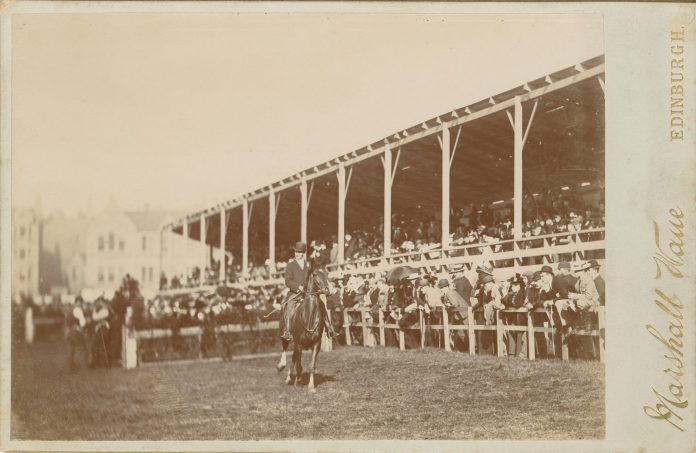The Kentucky Derby functions beyond racing horses, maintaining a deep central place within American society through traditions while displaying royal showmanship and historical significance. Since its inception almost 150 years ago, this well-known “Run for the Roses” competition continues to gather spectators worldwide who visit Churchill Downs in Louisville, Kentucky, each year. Since its 150th running this year, the Derby has created an optimal time to explore its treasured history. Tremendous horses and legendary jockeys remain central to the Kentucky Derby event, which still displays the distinctive pairing of extravagant hats with mint juleps while being an enduring representation of American sportsmanship through Southern charm.
Making it Official
The Kentucky Derby started its legacy through official recognition under the guidance of Meriwether Lewis Clark, who brought this historic event to existence through his ambitious plans. During his European visit, Clark was motivated to establish an equivalent American derby after witnessing the famous Epsom Derby in England. Under the financial and moral support of his uncles, John and Henry Churchill, Clark acquired land near Louisville, Kentucky, to establish a racetrack. The Louisville Jockey Club became the foundation, eventually transforming into Churchill Downs when the official name was established in 1928 after years of using the informal name. The history of the race developed through its early stages when the track started at 1.5 miles and later shrunk to its current length of 1.25 miles in 1896. Grandstands appeared in 1894 at the Kentucky Derby because attendance had reached massive proportions. Martin Winn took charge of the event in 1902 to reform its financial operations by reducing betting restrictions while establishing modified race charge fees. The modifications to the Derby enhanced its financial stability while converting it into a beloved country-wide celebration that united athletics with traditions and lavishness into the timeless spectacle.
The Derby Grabs America’s Spotlight
Martin Winn made the Derby appeal to celebrities, which established it as a significant star-gathering event down to the present day. Winn created the first live radio broadcasting technique, allowing fans to experience race excitement from their homes everywhere through radio waves. The Derby achieved its highest level of popularity in 1952 after its inaugural broadcast on nationwide television reached millions of viewers. The race achieved greater fame in 1931 because organizers set the dates to begin on the first Saturday of every May, creating the perfect timeline for potential Triple Crown searchers. After 1973, Secretariat achieved eternal recognition when he won with an unbeaten time of 1:59.40 during the 99th Derby. The recognition of Churchill Downs Racetrack as a National Historic Landmark in 1986 joined its racing heritage to its cultural value, ensuring the Derby’s status in American history and public sentiment.
The Jockey’s Legacy
At the first running of the Derby in 1875, Black jockeys contributed significantly since thirteen of fifteen riders were part of this group. The increase in Derby’s popularity allowed many enslaved former individuals to transition into jockeying and rise through the ranks of the sport. The history books named Isaac Murphy the first Black millionaire athlete because he won the 1890 and 1891 horse races while becoming a legendary figure. Black jockeys faced rising discrimination after their initial success in horse racing, so by 1911, most had been eliminated from the sport. The sporting world acquired new Latino jockey stars when Braulio Baeza won at the 1963 Belmont Stakes and Kentucky Derby. Horse racing reflects Latino prominence by having Latino jockeys make up about half of the Derby riders today. From 1970 until now, the Derby hosted six female jockeys, including Diane Crump, who became the first woman to compete in 1970. The Kentucky Derby continues gathering power from the unyielding spirit of jockey contestants even as women remain unsuccessful in winning the trophy.
The Modern Derby
Held annually, the Modern Derby unites celebrated customs and intense competitive events in a lively celebration. The annual derby begins when spectators perform “My Old Kentucky Home” before the first race, and this event reverberates across the stands during the festivities. The Derby winner concludes the race by receiving the red rose blanket, which symbolizes the event since 1904. No other edition since 2015 has gathered more spectators at the competition than the 170,500 who came to watch the races, representing recent history’s biggest turnout. The winning purse has increased dramatically from its original value to $5 million. Horse racing betting continues to be a substantial attraction because enthusiasts have placed bets surpassing $150 million in recent years while awaiting a new Triple Crown racing champion. In 2018, Justify became the most recent horse to conquer the Triple Crown challenge, which has generated anticipation for the future winner to join this elite club. Today’s Derby presents itself as more than racing horses since it is a magnificent event that captures millions of viewers while celebrating its lasting history.



 Bitcoin
Bitcoin  Ethereum
Ethereum  Tether
Tether  XRP
XRP  Solana
Solana  USDC
USDC  TRON
TRON  Cardano
Cardano  Lido Staked Ether
Lido Staked Ether  Avalanche
Avalanche  Toncoin
Toncoin